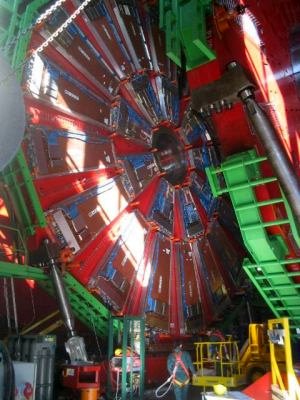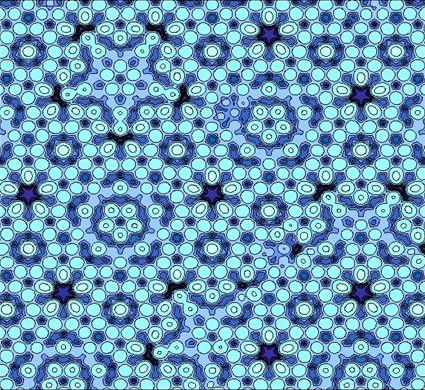|
X-ray Standing Waves
The X-ray standing wave (XSW) technique can be used to study the structure of surfaces and interfaces with high spatial resolution and chemical selectivity. Pioneered by B.W. Batterman in the 1960s, the availability of synchrotron light has stimulated the application of this interferometric technique to a wide range of problems in surface science. Basic principles An X-ray standing wave (XSW) field is created by interference between an X-ray beam impinging on a sample and a reflected beam. The reflection may be generated at the Bragg condition for a crystal lattice or an engineered multilayer superlattice; in these cases, the period of the XSW equals the periodicity of the reflecting planes. X-ray reflectivity from a mirror surface at small incidence angles may also be used to generate long-period XSWs. The spatial modulation of the XSW field, described by the dynamical theory of X-ray diffraction, undergoes a pronounced change when the sample is scanned through the Bragg condi ... [...More Info...] [...Related Items...] OR: [Wikipedia] [Google] [Baidu] |
X-ray
X-rays (or rarely, ''X-radiation'') are a form of high-energy electromagnetic radiation. In many languages, it is referred to as Röntgen radiation, after the German scientist Wilhelm Conrad Röntgen, who discovered it in 1895 and named it ''X-radiation'' to signify an unknown type of radiation.Novelline, Robert (1997). ''Squire's Fundamentals of Radiology''. Harvard University Press. 5th edition. . X-ray wavelengths are shorter than those of ultraviolet rays and longer than those of gamma rays. There is no universally accepted, strict definition of the bounds of the X-ray band. Roughly, X-rays have a wavelength ranging from 10 nanometers to 10 picometers, corresponding to frequencies in the range of 30 petahertz to 30 exahertz ( to ) and photon energies in the range of 100 eV to 100 keV, respectively. X-rays can penetrate many solid substances such as construction materials and living tissue, so X-ray radiography is widely used in medi ... [...More Info...] [...Related Items...] OR: [Wikipedia] [Google] [Baidu] |
Ultra-high Vacuum
Ultra-high vacuum (UHV) is the vacuum regime characterised by pressures lower than about . UHV conditions are created by pumping the gas out of a UHV chamber. At these low pressures the mean free path of a gas molecule is greater than approximately 40 km, so the gas is in free molecular flow, and gas molecules will collide with the chamber walls many times before colliding with each other. Almost all molecular interactions therefore take place on various surfaces in the chamber. UHV conditions are integral to scientific research. Surface science experiments often require a chemically clean sample surface with the absence of any unwanted adsorbates. Surface analysis tools such as X-ray photoelectron spectroscopy and low energy ion scattering require UHV conditions for the transmission of electron or ion beams. For the same reason, beam pipes in particle accelerators such as the Large Hadron Collider are kept at UHV. Overview Maintaining UHV conditions requires the use of ... [...More Info...] [...Related Items...] OR: [Wikipedia] [Google] [Baidu] |
Experimental Physics
Experimental physics is the category of disciplines and sub-disciplines in the field of physics that are concerned with the observation of physical phenomena and experiments. Methods vary from discipline to discipline, from simple experiments and observations, such as Galileo's experiments, to more complicated ones, such as the Large Hadron Collider. Overview Experimental physics encompasses all the disciplines of physics that are concerned with data acquisition, data-acquisition methods, and the detailed conceptualization (beyond simple thought experiments) and realization of laboratory experiments. It is often contrasted with theoretical physics, which is more concerned with predicting and explaining the physical behaviour of nature than the acquisition of empirical data. Although experimental and theoretical physics are concerned with different aspects of nature, they both share the same goal of understanding it and have a symbiotic relationship. The former provides data abou ... [...More Info...] [...Related Items...] OR: [Wikipedia] [Google] [Baidu] |
Laboratory Techniques In Condensed Matter Physics
A laboratory (; ; colloquially lab) is a facility that provides controlled conditions in which scientific or technological research, experiments, and measurement may be performed. Laboratory services are provided in a variety of settings: physicians' offices, clinics, hospitals, and regional and national referral centers. Overview The organisation and contents of laboratories are determined by the differing requirements of the specialists working within. A physics laboratory might contain a particle accelerator or vacuum chamber, while a metallurgy laboratory could have apparatus for casting or refining metals or for testing their strength. A chemist or biologist might use a wet laboratory, while a psychologist's laboratory might be a room with one-way mirrors and hidden cameras in which to observe behavior. In some laboratories, such as those commonly used by computer scientists, computers (sometimes supercomputers) are used for either simulations or the analysis of data. Scienti ... [...More Info...] [...Related Items...] OR: [Wikipedia] [Google] [Baidu] |
World Scientific
World Scientific Publishing is an academic publisher of scientific, technical, and medical books and journals headquartered in Singapore. The company was founded in 1981. It publishes about 600 books annually, along with 135 journals in various fields. In 1995, World Scientific co-founded the London-based Imperial College Press together with the Imperial College of Science, Technology and Medicine. Company structure The company head office is in Singapore. The Chairman and Editor-in-Chief is Dr Phua Kok Khoo, while the Managing Director is Doreen Liu. The company was co-founded by them in 1981. Imperial College Press In 1995 the company co-founded Imperial College Press, specializing in engineering, medicine and information technology Information technology (IT) is the use of computers to create, process, store, retrieve, and exchange all kinds of data . and information. IT forms part of information and communications technology (ICT). An information technolo ... [...More Info...] [...Related Items...] OR: [Wikipedia] [Google] [Baidu] |
List Of Surface Analysis Methods
This is a list of analysis methods used in materials science. Analysis methods are listed by their acronym, if one exists. Symbols * μSR – see muon spin spectroscopy * χ – see magnetic susceptibility A * AAS – Atomic absorption spectroscopy * AED – Auger electron diffraction * AES – Auger electron spectroscopy * AFM – Atomic force microscopy * AFS – Atomic fluorescence spectroscopy * Analytical ultracentrifugation * APFIM – Atom probe field ion microscopy * APS – Appearance potential spectroscopy * ARPES – Angle resolved photoemission spectroscopy * ARUPS – Angle resolved ultraviolet photoemission spectroscopy * ATR – Attenuated total reflectance B * BET – BET surface area measurement (BET from Brunauer, Emmett, Teller) * BiFC – Bimolecular fluorescence complementation * BKD – Backscatter Kikuchi diffraction, see EBSD * BRET – Bioluminescence resonance energy transfer * BSED – Back scattered electron diffraction, see EBSD C ... [...More Info...] [...Related Items...] OR: [Wikipedia] [Google] [Baidu] |
Heterogeneous Catalysts
In chemistry, heterogeneous catalysis is catalysis where the phase of catalysts differs from that of the reactants or products. The process contrasts with homogeneous catalysis where the reactants, products and catalyst exist in the same phase. Phase distinguishes between not only solid, liquid, and gas components, but also immiscible mixtures (e.g. oil and water), or anywhere an interface is present. Heterogeneous catalysis typically involves solid phase catalysts and gas phase reactants. In this case, there is a cycle of molecular adsorption, reaction, and desorption occurring at the catalyst surface. Thermodynamics, mass transfer, and heat transfer influence the rate (kinetics) of reaction. Heterogeneous catalysis is very important because it enables faster, large-scale production and the selective product formation. Approximately 35% of the world's GDP is influenced by catalysis. The production of 90% of chemicals (by volume) is assisted by solid catalysts. The chemi ... [...More Info...] [...Related Items...] OR: [Wikipedia] [Google] [Baidu] |
Self-assembled Monolayers
Self-assembled monolayers (SAM) of organic molecules are molecular assemblies formed spontaneously on surfaces by adsorption and are organized into more or less large ordered domains. In some cases molecules that form the monolayer do not interact strongly with the substrate. This is the case for instance of the two-dimensional supramolecular networks of e.g. perylenetetracarboxylic dianhydride ( PTCDA) on gold or of e.g. porphyrins on highly oriented pyrolitic graphite (HOPG). In other cases the molecules possess a head group that has a strong affinity to the substrate and anchors the molecule to it. Such a SAM consisting of a head group, tail and functional end group is depicted in Figure 1. Common head groups include thiols, silanes, phosphonates, etc. SAMs are created by the chemisorption of "head groups" onto a substrate from either the vapor or liquid phase followed by a slow organization of "tail groups". Initially, at small molecular density on the surface, adsorba ... [...More Info...] [...Related Items...] OR: [Wikipedia] [Google] [Baidu] |
Quasi-crystal
A quasiperiodic crystal, or quasicrystal, is a structure that is ordered but not periodic. A quasicrystalline pattern can continuously fill all available space, but it lacks translational symmetry. While crystals, according to the classical crystallographic restriction theorem, can possess only two-, three-, four-, and six-fold rotational symmetries, the Bragg diffraction pattern of quasicrystals shows sharp peaks with other symmetry orders—for instance, five-fold. Aperiodic tilings were discovered by mathematicians in the early 1960s, and, some twenty years later, they were found to apply to the study of natural quasicrystals. The discovery of these aperiodic forms in nature has produced a paradigm shift in the field of crystallography. In crystallography the quasicrystals were predicted in 1981 by a five-fold symmetry study of Alan Lindsay Mackay,—that also brought in 1982, with the crystallographic Fourier transform of a Penrose tiling,Alan L. Mackay, "Crystallograph ... [...More Info...] [...Related Items...] OR: [Wikipedia] [Google] [Baidu] |
Superlattice
A superlattice is a periodic structure of layers of two (or more) materials. Typically, the thickness of one layer is several nanometers. It can also refer to a lower-dimensional structure such as an array of quantum dots or quantum wells. Discovery Superlattices were discovered early in 1925 by Johansson and Linde after the studies on gold-copper and palladium-copper systems through their special X-ray diffraction patterns. Further experimental observations and theoretical modifications on the field were done by Bradley and Jay, Gorsky, Borelius, Dehlinger and Graf, Bragg and Williams and Bethe. Theories were based on the transition of arrangement of atoms in crystal lattices from disordered state to an ordered state. Mechanical properties J.S. Koehler theoretically predicted that by using alternate (nano-)layers of materials with high and low elastic constants, shearing resistance is improved by up to 100 times as the Frank–Read source of dislocations cannot operate i ... [...More Info...] [...Related Items...] OR: [Wikipedia] [Google] [Baidu] |
Diffusion
Diffusion is the net movement of anything (for example, atoms, ions, molecules, energy) generally from a region of higher concentration to a region of lower concentration. Diffusion is driven by a gradient in Gibbs free energy or chemical potential. It is possible to diffuse "uphill" from a region of lower concentration to a region of higher concentration, like in spinodal decomposition. The concept of diffusion is widely used in many fields, including physics (particle diffusion), chemistry, biology, sociology, economics, and finance (diffusion of people, ideas, and price values). The central idea of diffusion, however, is common to all of these: a substance or collection undergoing diffusion spreads out from a point or location at which there is a higher concentration of that substance or collection. A gradient is the change in the value of a quantity, for example, concentration, pressure, or temperature with the change in another variable, usually distance. A change in c ... [...More Info...] [...Related Items...] OR: [Wikipedia] [Google] [Baidu] |




